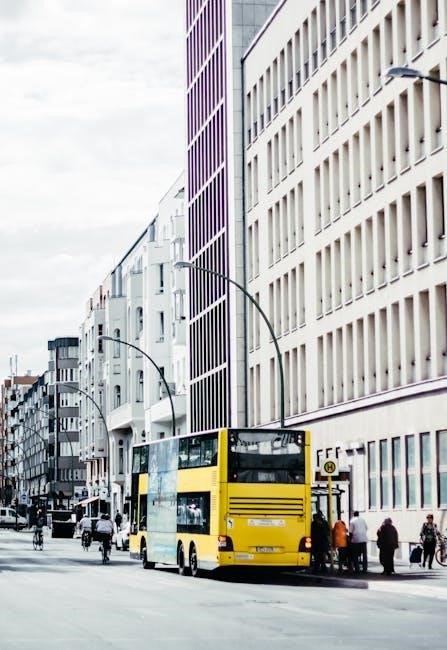
The BC Active Transportation Design Guide is a comprehensive resource published by the B.C. government in 2019 to promote safe and accessible active transportation networks.
It provides detailed planning and engineering guidelines for walking, cycling, and rolling, ensuring equitable and sustainable transportation solutions for communities across British Columbia.
1.1 Purpose and Scope of the Guide
The BC Active Transportation Design Guide aims to provide communities with best practices for designing safe, accessible, and inclusive active transportation infrastructure. Its scope includes walking, cycling, and rolling facilities, ensuring equitable access for all users. The guide offers detailed design guidelines, standards, and recommendations to support the development of multi-modal transportation systems. By promoting healthy, affordable, and environmentally friendly travel options, it helps create connected, vibrant communities across British Columbia. Updated regularly, it reflects evolving needs and priorities in active transportation.
1.2 Key Objectives of Active Transportation in British Columbia
The primary objectives of active transportation in British Columbia are to promote safe, inclusive, and accessible mobility for all users. This includes enhancing walkability, cycling infrastructure, and multi-use pathways to support healthy, affordable, and environmentally friendly travel. The guide aims to foster equitable access, reduce traffic congestion, and strengthen local economies by encouraging sustainable transportation choices. These objectives align with broader goals of improving public health, reducing greenhouse gas emissions, and creating livable, connected communities across the province.

Key Principles of Active Transportation Design
The BC Active Transportation Design Guide emphasizes designing safe, accessible, and connected infrastructure to promote walking, cycling, and rolling, fostering sustainable and equitable transportation options.
2.1 Universal Access and Inclusivity in Design
The BC Active Transportation Design Guide prioritizes universal access and inclusivity, ensuring facilities are usable by everyone, regardless of age, ability, or mobility aids. Design elements like curb cuts, audible signals, and tactile markings enhance accessibility for pedestrians. Cycling infrastructure includes features like wide bike lanes and accessible bike racks. Multi-use pathways are designed to accommodate diverse users, from walkers to wheelchair users, promoting equitable access to active transportation options for all British Columbians, fostering healthier, more connected communities.

2.2 Integration with Multi-Modal Transportation Systems
The BC Active Transportation Design Guide emphasizes the importance of integrating active transportation with public transit, roads, and other modes to create seamless connectivity. Design strategies include accessible pathways connecting to transit stops, bike racks, and storage facilities. This integration encourages multi-modal trips, reducing reliance on personal vehicles. By aligning active transportation infrastructure with broader transportation networks, the guide supports efficient, sustainable, and equitable mobility options for all users across British Columbia;

Infrastructure Design for Walking, Cycling, and Rolling
This section provides detailed design standards for pedestrian, cycling, and multi-use pathways, ensuring safe and accessible infrastructure that supports all human-powered transportation modes effectively.
3.1 Pedestrian-Focused Facilities and Amenities
Pedestrian-focused facilities emphasize universal access and safety, featuring wide sidewalks, curb extensions, and clear crosswalks. Amenities like benches, shelters, and wayfinding signage enhance comfort and accessibility. Lighting and landscaping improvements create welcoming public spaces, promoting walkability and social interaction. These designs prioritize inclusivity, ensuring all users, including those with mobility challenges, can navigate easily. The guide also highlights the importance of maintaining pedestrian infrastructure to support urban vitality and sustainable transportation options.
3.2 Cycling Infrastructure Design Standards
The guide outlines cycling infrastructure standards, emphasizing separated bike lanes, shared-use pathways, and intersection treatments. Design elements include bicycle signals, signage, and pavement markings to enhance safety. Standards ensure consistency across jurisdictions, promoting seamless travel for cyclists. The guide also addresses traffic calming measures and integration with public transit to create a cohesive, multi-modal network supporting active transportation goals in British Columbia.
3.3 Multi-Use Pathways and Shared Use Facilities

Multi-use pathways are designed to accommodate pedestrians, cyclists, and other non-motorized users, fostering inclusive and accessible transportation. The guide emphasizes wide, paved surfaces, clear signage, and lighting to ensure safety and comfort. Shared-use facilities, such as bike-and-pedestrian bridges, are prioritized to connect communities and reduce traffic congestion. These designs promote active transportation while integrating seamlessly with surrounding environments, encouraging healthier, more sustainable travel options for residents and visitors across British Columbia.

Design Considerations for Safety and Accessibility
The guide prioritizes universal access and safety in design, ensuring facilities are accessible to all users, including pedestrians, cyclists, and individuals with mobility challenges.
4.1 Traffic Calming Measures for Active Transportation
Traffic calming measures are essential to create safer environments for pedestrians, cyclists, and other road users. These measures include speed humps, narrowed lanes, and traffic circles, designed to reduce vehicle speeds and prioritize active transportation. By incorporating such elements, the guide aims to enhance safety, encourage walking and cycling, and foster a balanced transportation network. These strategies are critical for minimizing conflicts between motorized and non-motorized users, ensuring equitable access to roadways for all.
4.2 Wayfinding and Signage Best Practices
Effective wayfinding and signage are crucial for guiding users of active transportation networks. Clear, consistent, and visible signs help pedestrians, cyclists, and others navigate safely and efficiently. The guide recommends standardized signage designs that are easily understood by all users, including those with visual impairments. Digital wayfinding tools, such as maps and real-time information, should complement physical signs to enhance user experience. Proper signage placement ensures visibility and accessibility, fostering a seamless and intuitive transportation environment for everyone.

Intersections and Crossings
Intersections and crossings are critical points in active transportation networks, requiring careful design to ensure safety, accessibility, and smooth movement for all users, including pedestrians and cyclists.
5.1 Designing Safe Intersections for Active Transportation
Safe intersections are key to active transportation networks, requiring clear visibility, traffic calming measures, and dedicated signals for pedestrians and cyclists. The design should prioritize universal access, ensuring all users, including those with disabilities, can navigate confidently. Conflict zones must be minimized through smart geometry and clear signage. Pedestrian crossing times should be adequate, and cycling infrastructure should be seamlessly integrated to avoid conflicts with motorized traffic. These principles ensure intersections are both functional and safe for all modes of transportation.
5.2 Managing Crossings and Conflict Zones
Effective management of crossings and conflict zones is essential for ensuring safety and accessibility in active transportation networks. Design strategies should prioritize clear visibility, traffic calming, and minimal conflict points. Crossings must be designed with universal access in mind, incorporating features like audible signals and tactile markings. Conflict zones, such as intersections and shared pathways, require careful planning to minimize accidents and ensure smooth transitions between modes of transportation. Proper signage and enforcement also play critical roles in maintaining safety and order at these critical points;

Policy Framework and Implementation
The BC Active Transportation Design Guide outlines the Government of British Columbia’s policies to promote active transportation through funding, community engagement, and sustainable infrastructure development.
6.1 Role of Government in Promoting Active Transportation
The Government of British Columbia plays a critical role in promoting active transportation by providing frameworks, funding, and resources to support sustainable infrastructure development.
Through initiatives like the BC Active Transportation Design Guide, the government ensures communities have the tools to design safe, accessible, and integrated transportation systems, fostering healthier and more environmentally friendly travel options for all residents.
6.2 Funding and Community Engagement Strategies
Funding for active transportation initiatives in British Columbia is supported through government investments and partnerships, including federal contributions like the Active Transportation Fund.
Community engagement strategies involve public consultations, surveys, and stakeholder collaboration to ensure local needs are met and projects reflect community priorities, fostering inclusive and sustainable transportation solutions.

Case Studies and Success Stories
The guide highlights successful active transportation projects across British Columbia, showcasing improved safety, accessibility, and community engagement through innovative infrastructure designs and inclusive planning strategies.
7.1 Examples of Effective Active Transportation Projects in BC
The BC Active Transportation Design Guide features several exemplary projects, such as the CAD4 million investment in hydrogen fuel cell transportation and the CAD19 million allocated to six communities, including Tsleil-Waututh Nation and Matsqui First Nation, for active transportation initiatives. These projects, along with TransLink’s accessible infrastructure enhancements, demonstrate British Columbia’s commitment to sustainable and inclusive mobility solutions.

Future Updates and Revisions to the Guide
The BC Active Transportation Design Guide undergoes regular updates to incorporate best practices and public feedback, ensuring it remains a leading resource for sustainable transportation in British Columbia.
Future revisions will focus on emerging trends, new technologies, and policy changes, guided by input from communities and stakeholders to enhance active transportation infrastructure across the province.
8.1 Process for Public Input and Feedback
The BC Active Transportation Design Guide encourages public participation through online surveys and stakeholder consultations to gather feedback on proposed updates and revisions.
Individuals and organizations can submit comments through the Ministry of Transportation’s website, ensuring diverse perspectives are considered in the guide’s evolution.
Feedback is reviewed by a technical committee, with key recommendations incorporated into future editions, fostering a collaborative approach to improving active transportation infrastructure province-wide.




